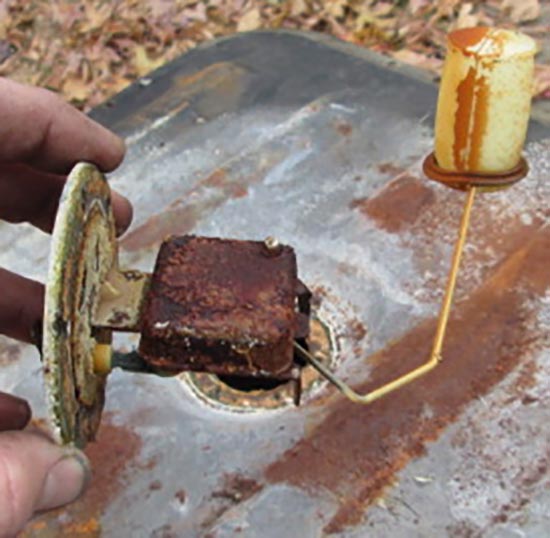Physical Bolt-In Fuel Sender Replacements for General Aviation.
CiES fuel level senders are a physical bolt-in replacement for many general aviation manufacturers for fuel tank quantity. Here you’ll find the models covered by the current FAA STC.
Please note: CiES fuel senders require a power wire for operation.
The complex sender circuitry in a CiES fuel sensor requires an extra wire to operate. For general installations, you can download installation instructions in pdf format or use our online installation instructions index to go directly to the desired section.
Unless otherwise specified, we support 30+ fuel gauges and instrument panels. These are also covered by the STC. If you require support for an existing gauge (aircraft must have a tank and gauge map), please contact us for details before ordering.
We also engineer custom solutions. Please contact us for more information.


FAA Approved (AML) STC
General Aviation Models
-
Aermacchi
(F.260, F.260B, F.260C, F.260D, F.260E, F.260F, S.205– 8/F, S.205 – 18/R, S.205-20/F S.205–20/R, S.205–22/R, S.208 S.208A)
-
American Champion
(7ECA, 7GCAA, 7KCAB, 7GCBC, 8KCAB, 8GCBC)
-
Amphibian Aircraft
(HU-16A, HU16B, HU-16C (UF-1, UF-1G), HU-16D (UF-2), HU-16E (UF2G))
-
Britten-Norman
(BN-2, BN-2A, BN-2A-6, BN2A-8, BN-2A-2, BN-2A-9, BN2A-3, BN-2A-20 BN-2T-4R, BN2A-21, BN-2A26, BN-2A-27, BN-2B-20, BN2B-21, BN-2B26, BN-2B-27, BN-2T2BN2A MK III, BN2A MK III-2, BN2A MK III-3)
-
Cataline Aircraft
(V28-5ACF)
-
Consolidated Vultee (Stinson)
(V-77)
-
Fairchild
(24 C8C, 24 C8CS)
-
Frakes Aircraft
(G-44 (Army OA14, Navy J4F-2), G-44A, G-73)
-
GA 8 Airvan
(GA8, GA8-TC320)
-
Helio Aircraft
(H-250 (USAF U-10D), H-295, HT-295 (USAFYL-24), H-391, H-391B (USAF L-28A or U-10B), H395, H-395A, H700, H-800)
-
Howard Aircraft
(DGA-15P (Army UC-70; Navy GH-1, GH-2, GH-3, NH-1), DGA-15J (Army UC-70B), DGA15W, 500)
-
Maule Air
(Bee Dee M-4, M-4, M-4C, M4S, M-4T, M-4-180C, M-4-180S, M-4-180T, M-4-210, M-4-210C, M-4-210S, M-4-210T, M-4-220, M-4-220C, M-4-220S, M-4-220T, M-5-180C, M5-200, M-5-210C, M-5-210TC, M-5-220C, M5-235C, M-6-180,
M-6-235, M-7-235, MX-7-235, MX-7-180, MXT-7-180, MT-7-235, M-8-235, MX-7-160, MXT-7-160, MX-7-180A, MXT-7-180A, MX-7-180B, M-7-235B, M-7-235A, M7-235C, MX-7-180C,M7-260, MT-7-260, M-7-260C, MX-7-160C, MX-7-180AC, M-9-235) -
Micco Aircraft
(MAC-145, MAC-125C, MAC145A, MAC-145B)
-
Pilatus Aircraft
(PC-6)
-
Reims Aviation
(F406)
-
REVO Incorporated
(COLONIAL C-1, COLONIAL C-2, LAKE LA-4, LAKE LA-4A, LAKE LA-4P, LAKE LA-4-200, LAKE MODEL 250)
-
Rockwell/Commander
(112, 112TC, 112B, 112TCA, 114, 114A, 114B, 114TC)
-
Sierra Hotel Aero (formerly Navion)
(Navion (L-17A), Navion A (L17B) (L-17C), Navion B, Navion D, Navion E, Navion F, Navion G, Navion H)
-
Sky Enterprises
(RC-3)
-
SOCATA
(TB 9, TB 10, TB 20, TB 21, TB 200)
-
Tecnam
(P2006T, P2010, P2012)
-
Textron Aviation
(65 (L-23F), 65-A90-1 (JU-21A), A65 (U-21A), A65-8200 (RU21A), 65-80 (RU21D), 65-A80 (U21G), 65-A80-8800 (RU-21H), 65-B80, 65-A90-2 (RU-21B), 65-88, 65-90, 65-A90 (RU-21H), 65-A90-3 (RU-21C), 65-A90-4 (RU21E), 70, B90, C90, C90A, C90GT, E90, H90 (T-44A), D17S (Army UC-43, UC*43B, Navy GB-1, GB2), SD17S)
-
Tiger Aircraft
(AA-5, AA-5A, AA-5B, AG-5B)
-
Twin Commander Aircraft
(500, 500A, 500B, 500U, 500S, 520, 560, 560A, 560E, 560-F, 680, 680E, 680F, 680F(P), 680FL, 680FL(P), 680T, 680V, 680W, 681, 685, 690, 690A, 690B, 690C, 690D, 695, 695A, 695B, 720)
-
Univair (Stinson)
(108, 108-1, 108-2, 108-3, 108-5)
-
Viking Air Limited (formerly de Havilland)
(DHC-2 Mk. I, DHC-2 Mk. II, DHC-2 Mk. III)
-
Vulcanair S.p.A.
(P.68, P.68 "Observer 2", P.68B, P.68C, P.68 "Observer", P.68TC "Observer'', P.68C-TC, V1.0)
-
Waco Aircraft
(YMF)
-
Zlin Aircraft
(Z-242L, Z-143L)
FAA Approved (AML) STC
Gauge Models
| Item | Cockpit Display Manufacturer | Cockpit Display Model | Data Converter (LRU1) | Fuel Sender Output Capability | Instrument Input Capability |
|---|---|---|---|---|---|
| 1 | JP Instruments | EDM 900 | N/A | Voltage 0-5 VDC | 0-4.7 VDC |
| 2 | JP Instruments | EDM 930 | N/A | Voltage 0-5 VDC | 0-4.7 VDC |
| 3 | JP Instruments | EDM 900 | N/A | Digital Frequency 64Hz-10kHz | 0-100 kHz |
| 4 | JP Instruments | EDM 930 | N/A | Digital Frequency 64Hz-10kHz | 0-100 kHz |
| 5 | Electronics International | MVP-50 | EDC-33P | Voltage 0-5 VDC | 0-18 VDC |
| 6 | Electronics International | CGR-30 | EDC-33P | Voltage 0-5 VDC | 0-18 VDC |
| 7 | Electronics International | MVP-50 | EDC-33P | Digital Frequency 64Hz-10kHz | 0-6 kHz |
| 8 | Electronics International | CGR-30 | EDC-33P | Digital Frequency 64Hz-10kHz | 0-6 kHz |
| 9 | Ultra FEI | Auracle CRM2120 | N/A | Voltage 0-5 VDC | 0-5 VDC |
| 10 | Aerospace Logic | FL25X | N/A | Voltage 0-5 VDC | 0-5 VDC |
| 11 | Aerospace Logic | FL20XD | N/A | Digital Frequency 64Hz-10kHz | 10-300 Hz |
| 12 | Aerospace Logic | FL21X | N/A | Voltage 0-5 VDC | 0-1 VDC |
| 13 | Aerospace Logic | FL20X | N/A | Voltage 0-5 VDC | 0-1 VDC |
| 14 | Garmin | G1000 | GEA 71 | Voltage 0-5 VDC | 0-5 VDC |
| 15 | Garmin | G950 | GEA 71 | Voltage 0-5 VDC | 0-5 VDC |
| 16 | Garmin | G1000 | GEA 71 | Voltage 0-5 VDC | 0-1 VDC |
| 17 | Garmin | G950 | GEA 71 | Voltage 0-5 VDC | 0-1 VDC |
| 18 | Garmin | G1000 | GEA 71 | Digital Frequency 64Hz-10kHz | 0-100 kHz |
| 19 | Garmin | G950 | GEA 71 | Digital Frequency 64Hz-10kHz | 0-100 kHz |
| 20 | Rochester Gauges | FQ-40XX Series | N/A | Voltage 0-5 VDC | 0-1 VDC |
| 21 | JP Instruments | EDM 960 | EDM 950 | Voltage 0-5 VDC | 0-4.7 VDC |
| 22 | JP Instruments | EDM 960 | EDM 950 | Digital Frequency 64Hz-10kHz | 0-100 kHz |
| 23 | Garmin | G500/G600 Txi | GEA 110 | Voltage 0-5 VDC | 0-5 VDC |
| 24 | Garmin | G500/G600 Txi | GEA 110 | Digital Frequency 64Hz-10kHz | 0-30,000 Hz |
| 25 | Garmin | G2000 | GEA 71 | Voltage 0-5 VDC | 0-1 VDC |
| 26 | Garmin | G3X | GEA 24 | Digital Frq 64Hz-10kHz, Vlt 0-5 VDC | 0-100 kHz, 0-5 VDC |
| 27 | Dynon | Skyview HDX | N/A | Voltage 0-5 VDC | 0-5 VDC |
| 28 | Garmin | GI 275 | GEA 24 | Digital Frq 64Hz-10kHz, Vlt 0-5 VDC | 0-100 kHz, 0-5 VDC |
| 29 | N/A | C662041-0101/2 | N/A | Voltage 0.01-2.78 VDC | Voltage 0.01-2.78 VDC |
| 30 | Garmin | G3X | GEA 24 | Digital Frq 64Hz-10kHz, Vlt 0-5 VDC | 0-100 kHz, 0-5 VDC |
| 31 | Dynon | Skyview HDX | N/A | Voltage 0-5 VDC | 0-5 VDC |
| 32 | Garmin | GI 275 | GEA 24 | Digital Frq 64Hz-10kHz, Vlt 0-5 VDC | 0-100 kHz, 0-5 VDC |
| 33 | N/A | C662041-0101/2 | N/A | Voltage 0.01-2.78 VDC | Voltage 0.01-2.78 VDC |
CiES Explains
What is a fuel sender?
Fuel senders are components of your aircraft's fuel system responsible for measuring the level of fuel in the fuel tanks and sending that information to the fuel gauge.
The fuel senders are located inside the aircraft's fuel tanks and consists of a nitrile rubber (NBR) float, a hard-anodized aluminum rotor and housing, nickel-plated Neodymium magnets, complex electronic equipment (outside the fuel tank) and other quality components.
As the level of fuel in the tank changes, the float attached to the fuel sender also changes position. The float arm moves inside the rotor, which is connected electronically to the fuel gauge. When the fuel tank is full, the float will be at the top of the tank, causing the magnetic resonance system to send a signal to the fuel gauge indicating that the tank is full. As the fuel level in the tank drops, the float will move down, causing the system to send a signal to the fuel gauge indicating fuel level has decreased.
With over 100,000 CiES fuel tank level sender units in the field and 900,000+ hours of trouble-free operation, we are a trusted ally of GA owners and quality aircraft manufacturers. In addition, CiES exceeds 90,000 hrs. mean time to failure (MTTF), making our fuel quantity one of the most reliable aviation systems in existence.


CiES Explains
Common symptoms and problems with bad fuel senders
A fuel sender is a component of an aircraft fuel system that measures the amount of fuel in the fuel tanks and sends that information back to the fuel gauge. When a fuel sender goes bad or fails, the fuel gauge may not accurately display the fuel level. This can be frustrating and potentially dangerous.
Here are some symptoms of bad fuel sender units:
- Inaccurate fuel gauge readings: The most common symptom of a bad fuel sender is an inaccurate fuel gauge reading. The gauge may read full when the tank is actually empty, or vice versa.
- Fluctuating fuel gauge readings: Another symptom of a bad fuel sender is a fuel gauge that fluctuates between full and empty, even when the tank is neither full nor empty. It may also behave erratically.
- Fuel gauge needle sticking: A fuel gauge needle that sticks in one position or doesn't move at all can also be a sign of a faulty fuel sender.
Do you need to purchase new fuel sending units for your aircraft? Fill out our order form here.



